 Not All Robots, Vol. 1
Not All Robots, Vol. 1
Writer: Mark Russell
Artist: Mike Deodoto Jr.
Colorist: Lee Loughridge
Letterer: Steve Wands
Publisher: AWA Studios – Upshot
Published: March 2022
It’s not every day that a robot story can be both funny and an important examination of the way capitalism creates waves of ruling classes. In an essay in the back of Not All Robots, writer Mark Russell explains that the original intent of the story was to examine the ways a culture of toxic masculinity responded to the Me Too movement. By using multiple robot revolutions, it ends up being much more of a story about labor and the ways certain wealthy parties manipulate people (and robots) into making themselves obsolete. One of the things that impressed me most about Not All Robots is that it was fun to read, and it was only later that I began to unpack the many layers of social reflection.
It’s 2056, people are living in bubble cities and robots have taken over the workforce. It’s not hard to imagine a world where the better option would be to completely bubble over a city and create dedicated tram lines to other domed metropolises. Humans had their chance to save the earth, and failed. So when the robots took control of the workforce and the cities, they made the decision to restrict the cities and contain them. The robots work all but one job – they couldn’t be hairdressers. They tried it, but it was way too dangerous to allow so many sharp fingers that close to delicate human heads, which is just one of many funny one-off panels that slowly gain more and more meaning in the world of the comic. Because the hairdressers were the last human workers, they act as a labor union and uprising party by default; they form an underground movement to oppose the robots.
This balance between dystopian comedy and emotional drama within a world where robots are the primary story mechanic, and where humans become a sort of fickle class without much purpose, is wonderfully characterized by artist Mike Deodoto Jr. At some point in the story there are two (or three) generations of robots that inhabit the world simultaneously, and it is so clear that a lot of thought went into how the first generation would be portrayed. They take on a kind of classic robot look, ala Short Circuit or Star Wars, and say things like “dear bot” instead of “dear God.” These little details all add up as you make your way through the first volume to create a sense of place and personhood for the robots we follow. Counter to the robots are the humans, who also inhabit a certain kind of place in the world. No longer needed, they mostly stay home and live a socially secluded life. Watching tv, working out. Planning revolutions against their robot leaders.
In one of the major pivot points for the early story, one of these bubbles has an oxygen imbalance and a lot of humans die – the entire city, in fact. But the robots are fine, of course. There’s some debate about whether this catastrophic (human) death event was an intentional move on the part of the robot in charge of the air filtration units, which sets up a lot of tension in society and enforced the divisions of classes pretty strongly. What better moment would there be to reveal that there is another level of robot about to be released and, of course, a wealthy ruling class pulling the strings. These figures sit in dark moments of the comic (literally, but also figuratively) making small plays to rebalance the peace (or not). After the oxygen incident, for example, they make a change to every robot’s name in order to make them more personable. Instead of Shredder, the robot would then be named Muffin or Blankets. Something soft and non-threatening.
I think a more rushed story would have only had one or two social elements, but Not All Robots manages to ratchet the tension up in a number of different ways. Tensions in human vs robot circles, tensions in robot vs robot circles, and tension in human family circles. Smartly, there is a human family at the center of the story to provide some sort of relative insight into what it would be like to live in a time like this – where the tired, verging on upset, robot working member of the family is forced into the perspective of two kinds of family politics. One that wants the robot to be happy and like them, and one that fears the robots will one day Oxygen-Incident them to death.
At the end of volume one, a lot of things have come to a head. People have been murdered, robots have been usurped by other new robots, and some people have been legally banished from the dome city. But again I want to say: I had a great time reading this comic. It was funny and interesting, every scene felt well thought through and detailed. The coloring, by Lee Loughridge, and lettering, by Steve Wands, do a lot of work to make sure it is very clear who belongs to what kind of physical body, which begins to blur a bit at the end in a fun way. It has a lot to say, but by projecting some of our social issues onto another distinct class of being – a robot – Not All Robots tells a subtle and apt story for our time. When asked in a Previews World interview about if the story was pro- or anti-robot, Mark Russell said this: “It’s against reducing people and robots to their economic function. It’s pro-accepting that people (and robots) have value independently of how economically useful they are.”
Verdict: Buy
Not All Robots, Vol. 1 is out now.
Read more trade collection reviews every Thursday in our Trade Rating column!


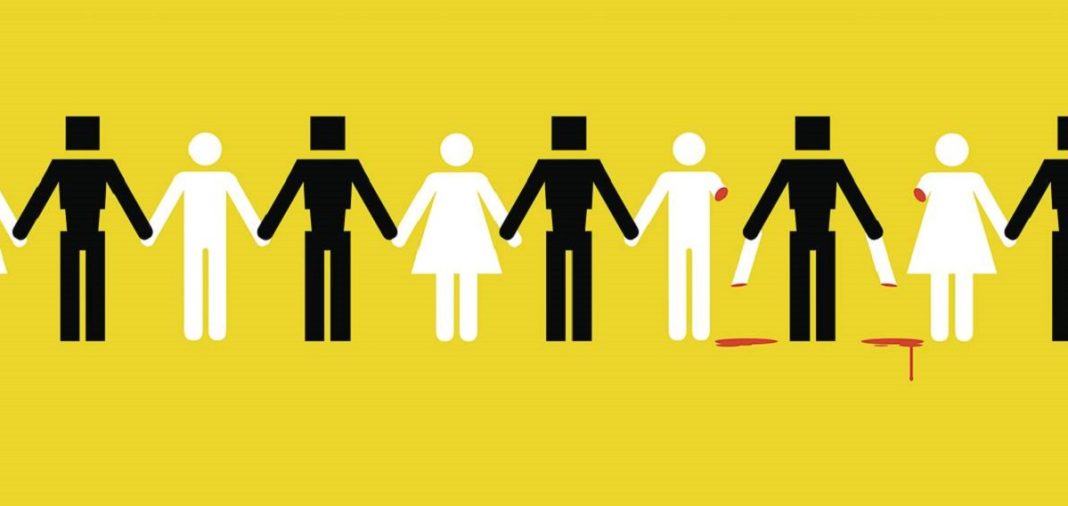
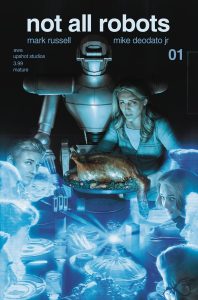
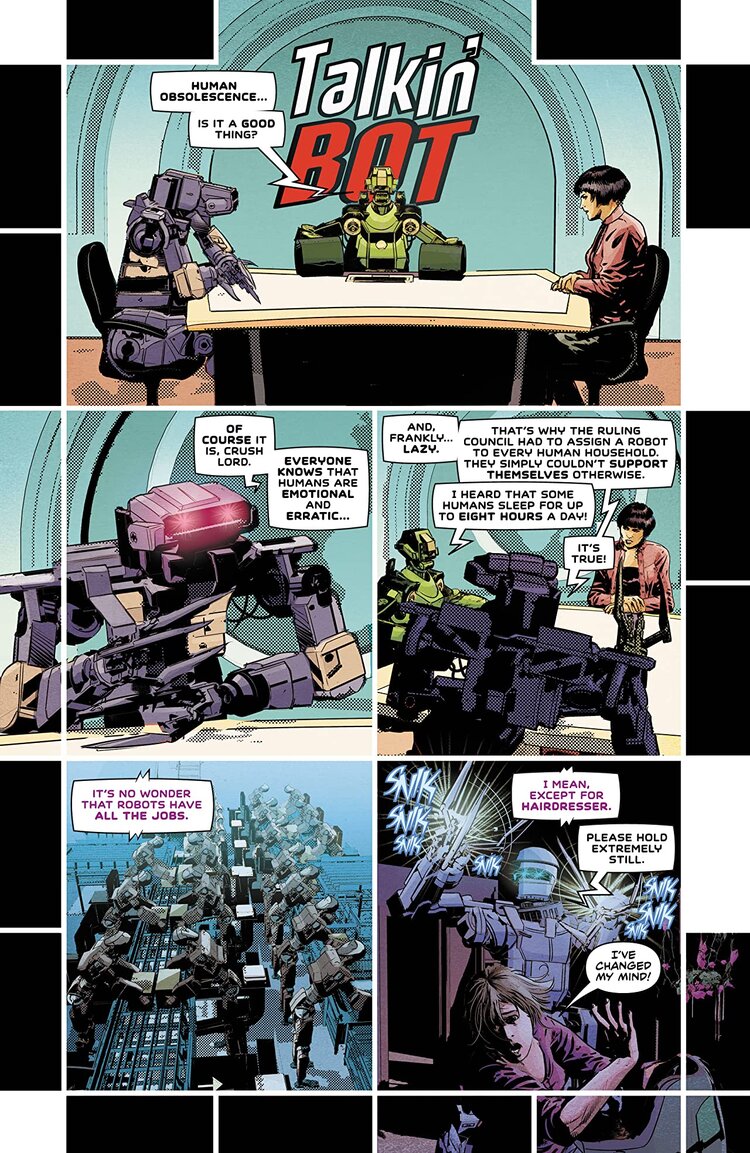
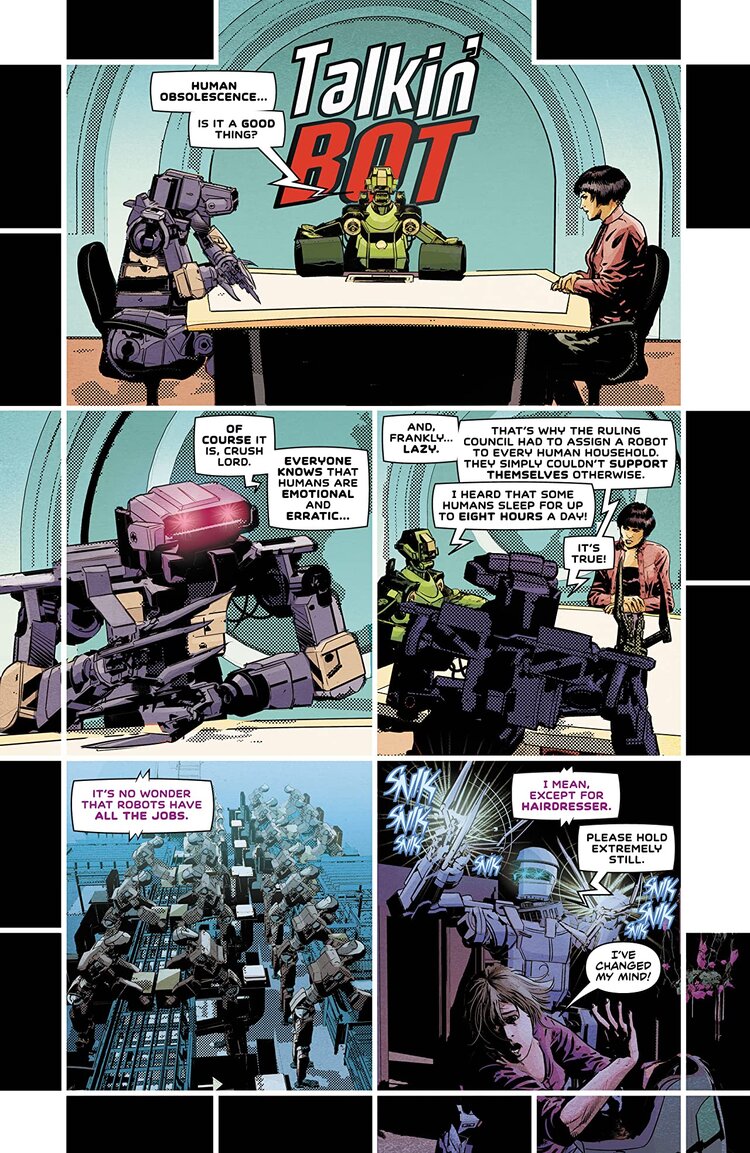
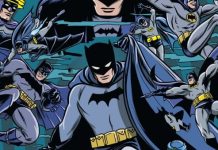





Got this and yes, a great book. But PLEASE do something about these banner ads at the bottom of the screen! I can’t seem to send a Screenshot here but they CANNOT be removed/blocked/eliminated. They really make the reading experience a lot worse than it should be. PLEASE have your ad people fix this, it should not be that you cannot remove them. I use both Chrome and Firefox and they are the same in both browsers. I would be happy to send a screenshot. Might try posting on your FB page now that I think about it.
Comments are closed.